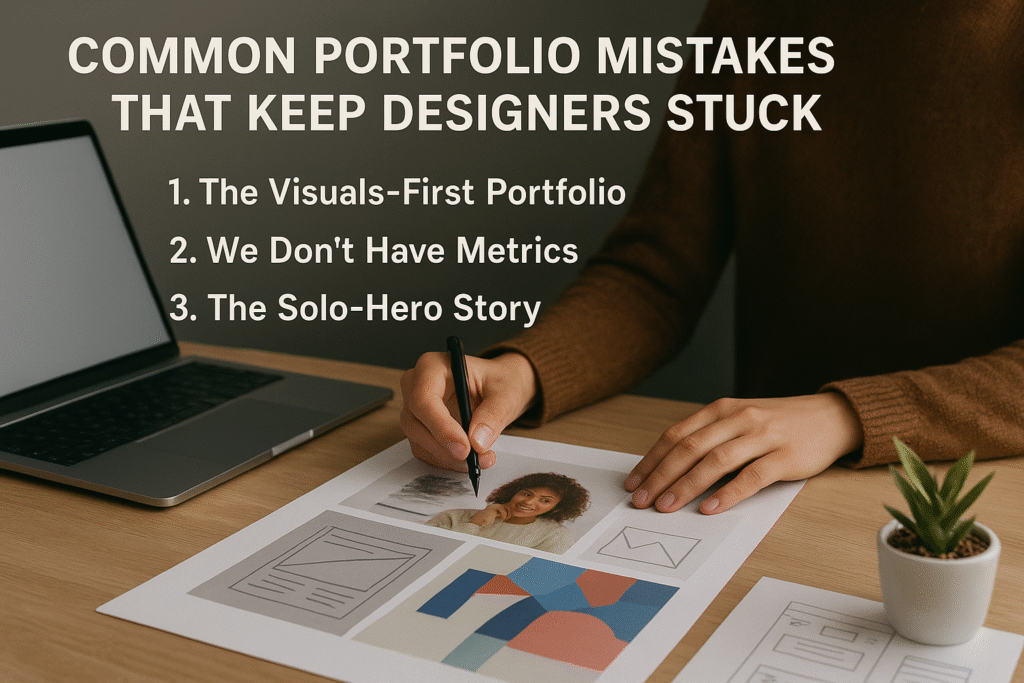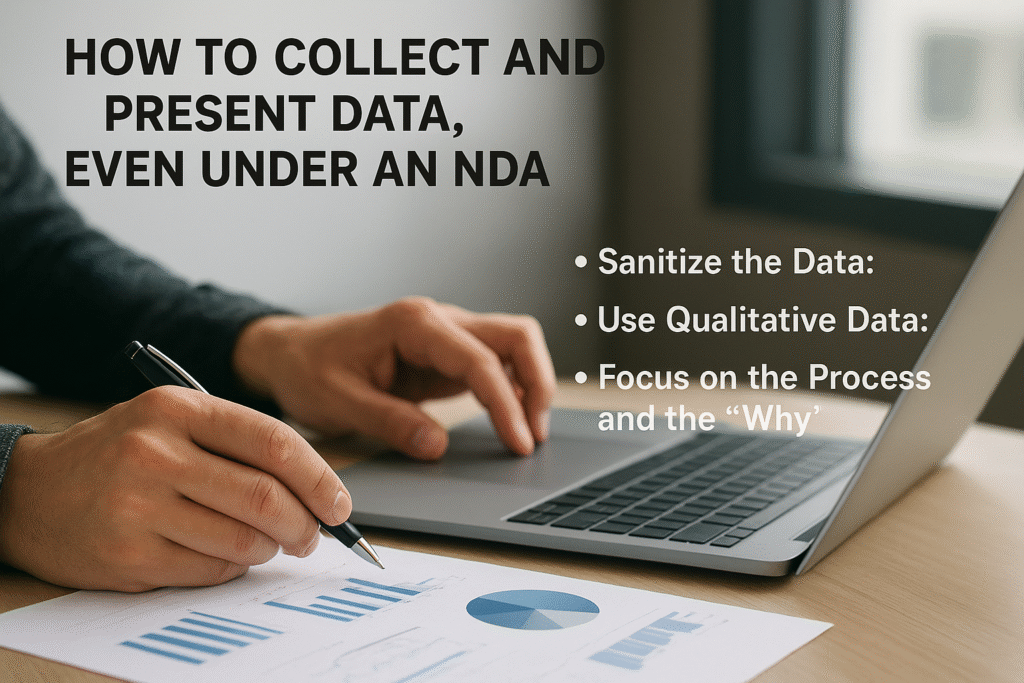Guide to Showcasing Business Impact in Your UX Portfolio
This blog is for UX designers wishing to move beyond the visuals to show real business impact to showcase in their portfolios. In this blog you will learn how to shape your UX case studies around thinking strategically, metrics, and collaborating cross-functionally to demonstrate measurable impact.
We will provide some useful frameworks such as the C-STAR framework, and tips on how to present data you could not present under NDAs or in your portfolio due to confidentiality issues. These techniques are especially helpful for mid to senior designers that are ready to progress, and to help you separate your portfolio and case studies for online UX training, workshops and in new leadership roles. Overall, this is a great thing to practice in building your portfolio as a strategic, value-adding designer.
From Pixel-Pusher to Impact-Maker: Your Guide to a Business-Driven UX Portfolio
Ready to level up your UX career? When it comes to transitioning from mid-level designer to senior, lead or manager, your focus will shift from simply creating aesthetically pleasing interfaces to demonstrating that your designs not only look good, but are also a good business decision.
Most UX portfolios consist mostly of pretty screens, a handful of detailed user flows and a touch of a design process. You’ve spent a lot of time refining, designing and redrafting the visual elements, making sure it’s all just right. However, if you really want to get attention in your application for a senior role, that’s not enough. You must start demonstrating your work, and its business outcome.
At a senior level, hiring managers and recruiters are not simply looking for a candidate who can sketch out a wireframe. They are looking for someone who can create value, work within a stakeholder team, and create business impact. They want evidence that you think strategically and understand the big picture. This guide will help you to evolve from “screens and visuals” and show the real value of design impact to you, your team and the business.
Why Your UX Portfolio Needs to Speak the Language of Business
Consider it from a hiring manager’s point of view. They are not hiring a designer; they are hiring a problem solver who is going to have some impact on the bottom line of the company. When they are looking at your portfolio, they are actually thinking:
- “Did this person’s work actually impact the bottom line?”
- “Can they work together with product, engineering, and marketing to achieve business outcomes?”
- “Can they understand the tradeoffs between business outcomes and user needs?”
A portfolio full of visuals answers none of these questions. It demonstrates skill but does not show value. A portfolio that communicates business outcomes demonstrates that the designer is a strategic partner rather than a service provider. This is the difference between a mid-level and a senior UX designer.
Common Portfolio Mistakes That Keep Designers Stuck

Before we dive into how to fix it, let’s look at the three most common mistakes keeping designers from landing those senior roles:
- The Visuals-First Portfolio: This is the most prevalent issue. Case studies are a timeline of a project, from discovery to high-fidelity mockups, but they often stop there. The focus is on the “how,” not the “what happened.” You’ll see a beautiful UI, but no mention of how it performed.
- We Don’t Have Metrics: A popular excuse among designers where they feel incapable of showcasing impact because they do not have explicit metrics. They might not have access to a data dashboard, or might just feel it is not their job. This is a missed opportunity. Impact is not just about quantitative improvements, it is also about qualitative improvements.
- The Solo-Hero Story: Your portfolio probably tells a small story about “I did this”, “I designed that” experience. However, when you reach senior roles, it is more about collaborating with “others”. A hiring manager will want to know how you collaborated with product managers, engineers, and stakeholders to make decisions. Not just “I designed ____.” They are looking for your ability to influence and lead, rather than execute.
How to Frame Your Business Outcomes
Moving past those mistakes means shifting your mindset. Here’s how to reframe your case study to highlight your true design impact.
- Connect Your Work to Metrics: If you can get your hands on quantitative metrics, use them! But don’t throw out some numerical values, tell a story! Instead of saying “I enhanced the checkout flow,” say “We redesigned the checkout flow and dropped cart abandonment by 15%, resulting in an estimated $500,000 increase to our yearly revenue.” You are directly connecting your work as a designer to a business win.
- Input Metrics: These are the examples of things you can have direct manipulative change on. Think A/B test results, task completion, usability scores, etc.
- Output Metrics: Output metrics are results that can occur from your work. Think revenue increase, decrease in support tickets or customer retention.
- Quantifying User Impact: For example, even if you can’t connect things with direct business metrics, you can show impact on the user. “Through usability testing and iterative design we improved the task completion time of a critical user flow by 30%, this created a better, more efficient, and less frustrating experience for our customers.”
- Demonstrate Your Strategic Approach: Use your story to discuss the trade-offs you had to make. Did you compromise on a design in order to meet an aggressive deadline? Make the decision explained. Did you do any user research and advocate for a product feature that was not on the roadmap? This shows you are a strategic partner, not just an executor!
- Demonstrate Collaboration and Influence: Instead of saying, “I created a design system,” you can say, “I partnered with three engineers and a product manager to define and implement a new design system, which resulted in us reducing our design HTML code (or inputting modified the design) time to development by 20%!” This indicates you can influence and work with cross-functional teams; you are driving the initiative, not just ‘executing orders’.
Frameworks and Examples for Your Portfolio
You don’t need to reinvent the wheel. Here are a few practical ways to structure your case studies to showcase impact.
The C-STAR Method
This is a simple but powerful framework to tell an impact-driven story:
- Context: Briefly describe the business problem and the user’s needs.
- Situation: What was the specific challenge you faced?
- Task: What was your role and the specific tasks you were responsible for?
- Action: What did you do? (This is where your design process lives, but keep it concise).
- Result: What was the outcome? This is where you bring it all home with the metrics and business results.
Before: “I designed a new dashboard for a financial app.”
After (using C-STAR): “The financial app was seeing a 10% drop-off on their main dashboard (Context). Users were overwhelmed by the amount of data and couldn’t find key information quickly (Situation). My task was to redesign the dashboard to improve clarity and engagement (Task). I conducted user interviews and created a new modular design (Action). The result was a 15% increase in daily active users and a 5% increase in click-through rates on key features (Result).”
How to Collect and Present Data, Even Under an NDA

One of the biggest hurdles is the NDA. But an NDA doesn’t prevent you from talking about impact. It just means you have to be clever.
- Sanitize the Data: Can you use percentages or relative numbers instead of absolute values? Instead of “increased revenue by $1.2M,” say “increased revenue by 10% year over year.”
- Use Qualitative Data: If you can’t share numbers, share insights from user research. Did your design improve user confidence? Did you receive positive feedback from a beta group?
- Focus on the Process and the “Why”: Your portfolio isn’t a financial report. The goal is to show your thinking. Explain how you would have measured success even if you can’t share the exact numbers. For example: “While I can’t share the exact metrics, we tracked key performance indicators like task completion rates and user satisfaction scores. The feedback from our beta group was overwhelmingly positive, noting a significant reduction in the steps required to complete a transaction.”
Actionable Steps to Transform Your Portfolio
Ready to get started? Here’s your game plan:
- Pick One Project: Don’t try to overhaul your entire portfolio at once. Choose one strong project that you can confidently reframe.
- Dig for Data: Go back through your old project notes, Slack channels, and emails. Did your product manager mention a key metric after launch? Did your a/b test results get shared in a team meeting?
- Find Your “Why”: For each project, ask yourself: Why did we build this? What business or user problem did it solve?
- Rewrite with the C-STAR Method: Use this framework to restructure your case study. Lead with the problem, provide a concise overview of your actions, and, most importantly, end with the results.
- Seek Feedback: Share your revised case study with a trusted colleague, a mentor, or even a hiring manager you know. Ask them if the business value is clear.
Your Portfolio is a Business Asset
Your UX portfolio is more than just a gallery of your work. It’s a strategic document that showcases your ability to deliver value. By focusing on business outcomes, design impact, and strategic thinking, you’re not just showing what you’ve done; you’re showing what you’re capable of doing.
It’s time to move beyond the pixels and prove your worth as a strategic partner. Take a moment right now to open one of your portfolio case studies. How can you reframe the beginning to focus on the problem and the end to highlight the result?


